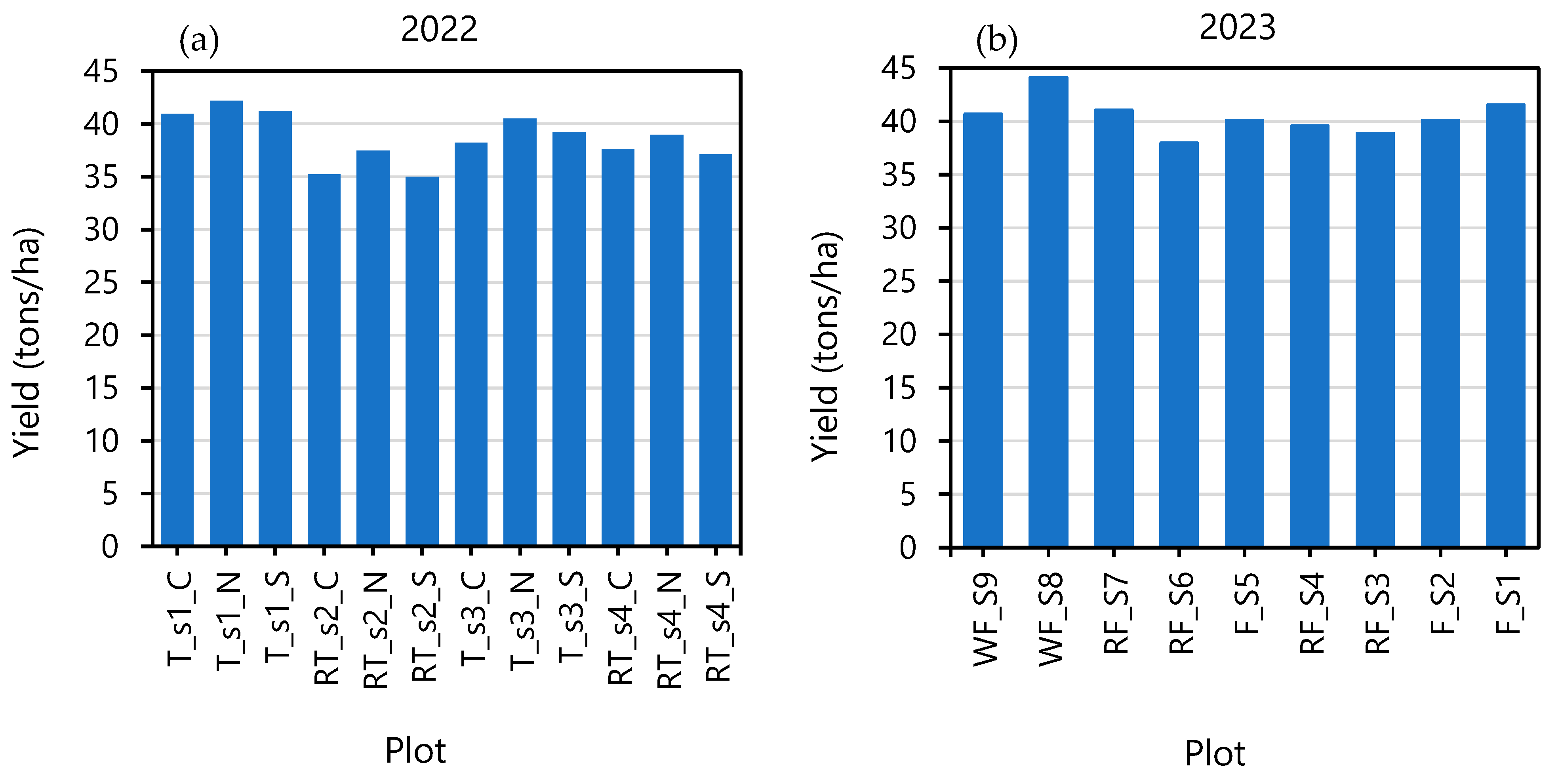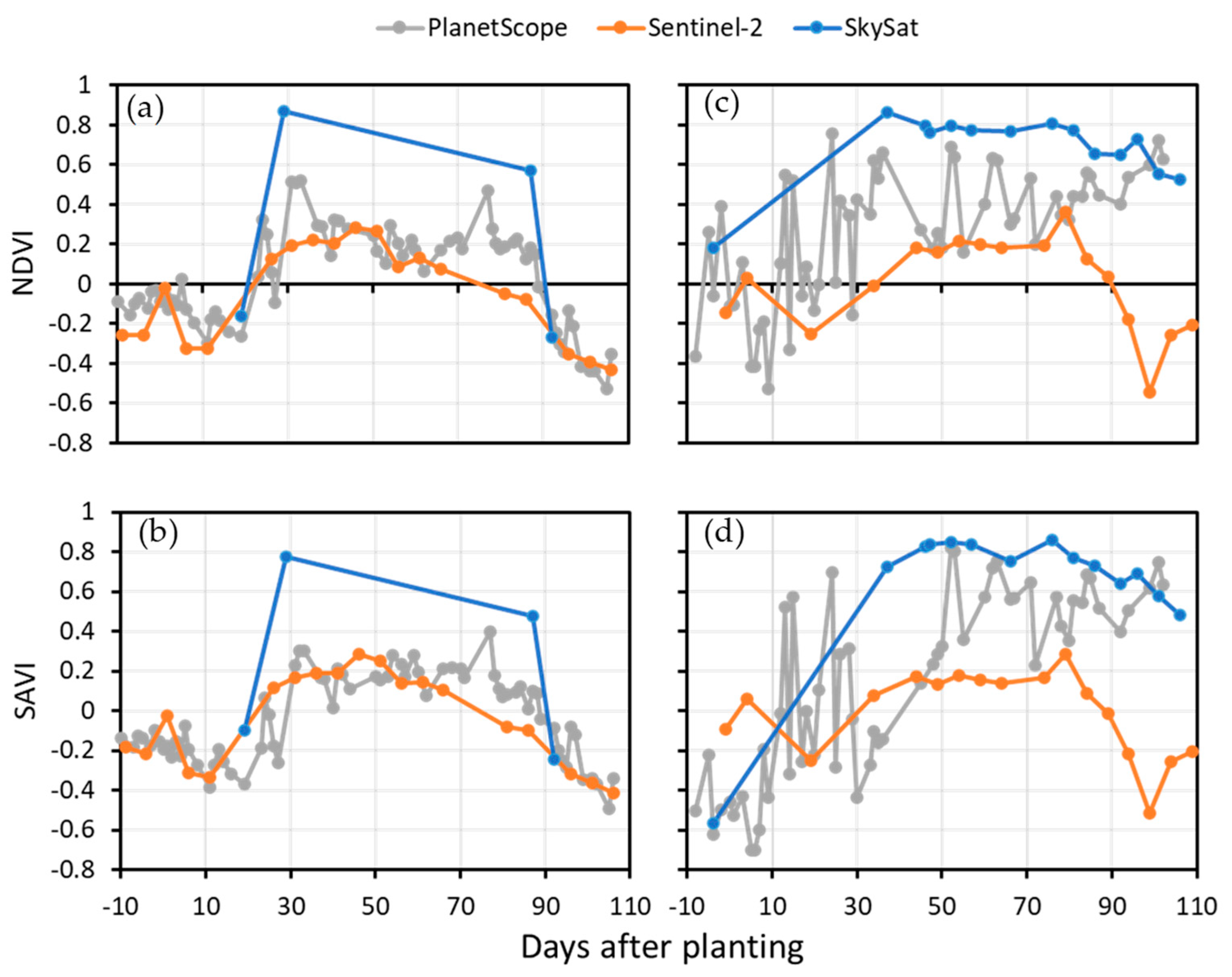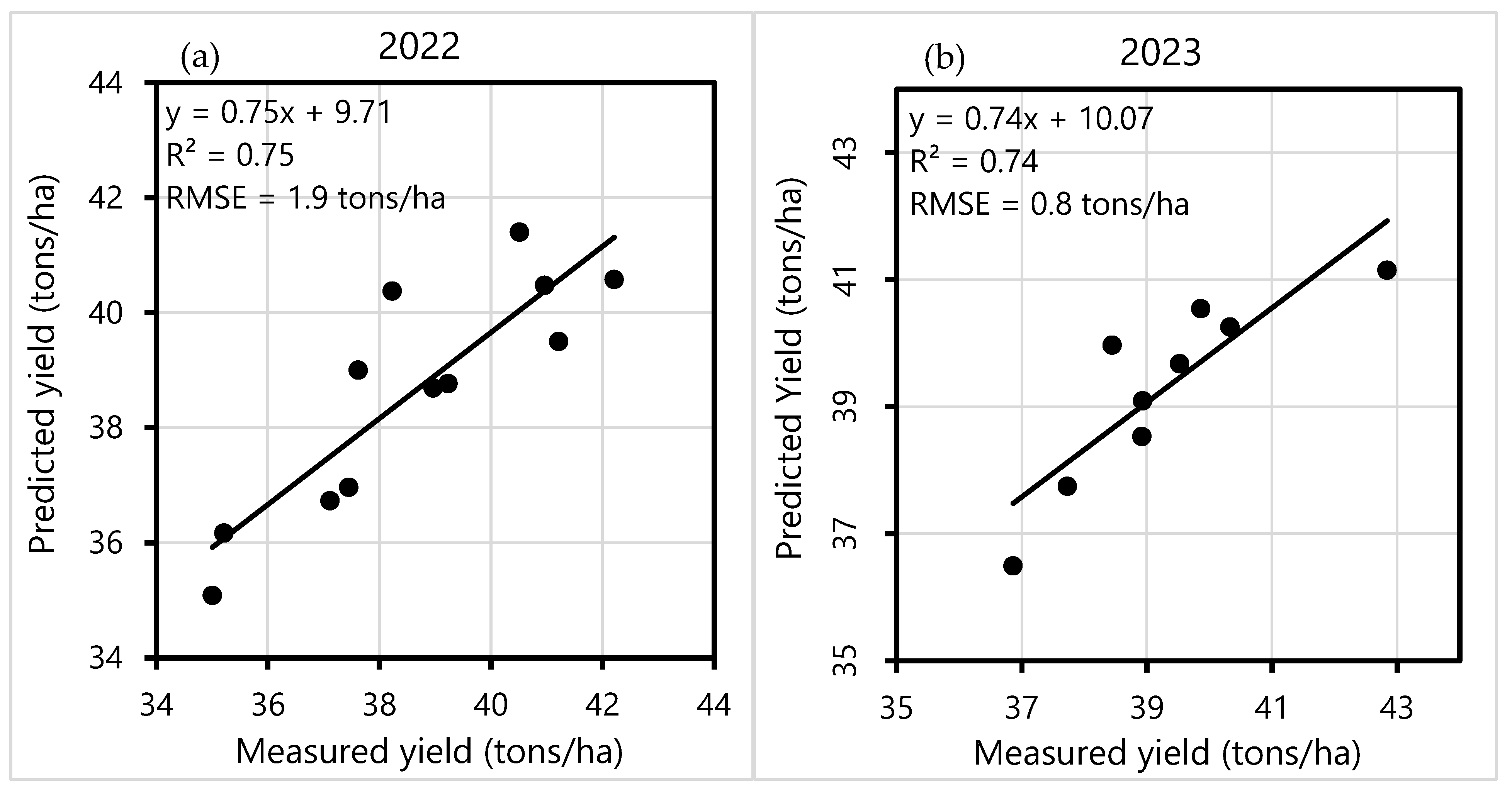In-Season Estimation of Japanese Squash Using High-Spatial-Resolution Time-Series Satellite Imagery
Abstract
1. Introduction
2. Materials and Methods
2.1. Study Site
2.2. Field Experiment Design
2.3. Satellite Image Acquisition and Processing
2.3.1. Sentinel-2
2.3.2. PlanetScope
2.3.3. SkySat
2.4. Vegetation Indices
2.5. Analysis and Evaluation
3. Results and Discussion
3.1. Time-Series Vegetation Index and Phenological Stage
3.2. Correlation Between Yield and Vegetation Index
3.3. Predicting Yield
4. Conclusions
Supplementary Materials
Author Contributions
Funding
Data Availability Statement
Acknowledgments
Conflicts of Interest
References
- Santos, C.; Lorite, I.J.; Tasumi, M.; Allen, R.G.; Fereres, E. Integrating Satellite-Based Ev Huete apotranspiration with Simulation Models for Irrigation Management at the Scheme Level. Irrig. Sci. 2008, 26, 277–288. [Google Scholar] [CrossRef]
- Muñoz-Huerta, R.F.; Guevara-Gonzalez, R.G.; Contreras-Medina, L.M.; Torres-Pacheco, I.; Prado-Olivarez, J.; Ocampo-Velazquez, R.V. A Review of Methods for Sensing the Nitrogen Status in Plants: Advantages, Disadvantages and Recent Advances. Sensors 2013, 13, 10823–10843. [Google Scholar] [CrossRef]
- Bright; Zack, L.; Handley, M.; Chien, I.; Curi, S.; Brownworth, L.A.; D’hers, S.; Bernier, U.R.; Gurman, P.; Elman, N.M. Analytical Models Integrated with Satellite Images for Optimized Pest Management. Precis. Agric. 2016, 17, 628–636. [Google Scholar] [CrossRef]
- Johnson, D.M. An Assessment of Pre- and within-Season Remotely Sensed Variables for Forecasting Corn and Soybean Yields in the United States. Remote Sens. Environ. 2014, 141, 116–128. [Google Scholar] [CrossRef]
- Inoue, Y. Satellite- and Drone-Based Remote Sensing of Crops and Soils for Smart Farming—A Review. Soil Sci. Plant Nutr. 2020, 66, 798–810. [Google Scholar] [CrossRef]
- Chen, Y.; Tao, F. Potential of remote sensing data-crop model assimilation and seasonal weather forecasts for early-season crop yield forecasting over a large area. Field Crops Research. 2022, 276, 108398. [Google Scholar]
- Ziliani, M.G.; Altaf, M.U.; Aragon, B.; Houborg, R.; Franz, T.E.; Lu, Y.; Sheffield, J.; Hoteit, I.; McCabe, M.F. Early Season Prediction of Within-Field Crop Yield Variability by Assimilating CubeSat Data into a Crop Model. Agric. For. Meteorol. 2022, 313, 108736. [Google Scholar] [CrossRef]
- Basso, B.; Liu, L. Chapter Four-Seasonal Crop Yield Forecast: Methods, Applications, and Accuracies. In Advances in Agronomy; Sparks, D.L., Ed.; Academic Press: Cambridge, MA, USA, 2019; Volume 154, pp. 201–255. [Google Scholar] [CrossRef]
- Schwalbert, R.A.; Amado, T.J.C.; Nieto, L.; Varela, S.; Corassa, G.M.; Horbe, T.A.N.; Rice, C.W.; Peralta, N.R.; Ciampitti, I.A. Forecasting Maize Yield at Field Scale Based on High-Resolution Satellite Imagery. Biosyst. Eng. 2018, 171, 179–192. [Google Scholar] [CrossRef]
- Tunca, E.; Köksal, E.S.; Taner, S.Ç. Silage Maize Yield Estimation by Using Planetscope, Sentinel-2A and Landsat 8 OLI Satellite Images. Smart Agric. Technol. 2023, 4, 100165. [Google Scholar] [CrossRef]
- Huete, A.R. A Soil-Adjusted Vegetation Index (SAVI). Remote Sens. Environ. 1988, 25, 295–309. [Google Scholar] [CrossRef]
- You, J.; Li, X.; Low, M.; Lobell, D.; Ermon, S. Deep Gaussian Process for Crop Yield Prediction Based on Remote Sensing Data. In Proceedings of the AAAI Conference on Artificial Intelligence, San Francisco, CA, USA, 4–9 February 2017; Volume 31. [Google Scholar] [CrossRef]
- Jain, M.; Balwinder Singh, A.; Srivastava, A.K.; Malik, R.K.; McDonald, A.J.; Lobell, D.B. Using Satellite Data to Identify the Causes of and Potential Solutions for Yield Gaps in India’s Wheat Belt. Environ. Res. Lett. 2017, 12, 094011. [Google Scholar] [CrossRef]
- Rao, P.; Zhou, W.; Bhattarai, N.; Srivastava, A.K.; Singh, B.; Poonia, S.; Lobell, D.B.; Jain, M. Using Sentinel-1, Sentinel-2, and Planet imagery to map crop type of smallholder farms. Remote Sens. 2021, 13, 1870. [Google Scholar] [CrossRef]
- Planet Team. Planet Imagery Product Specifications; Planet Labs: San Francisco, CA, USA, 2018; Available online: https://assets.planet.com/docs/Combined-Imagery-Product-Spec-Dec-2018.pdf (accessed on 10 August 2024).
- Gokool, S.; Mahomed, M.; Brewer, K.; Naiken, V.; Clulow, A.; Sibanda, M.; Mabhaudhi, T. Crop mapping in smallholder farms using unmanned aerial vehicle imagery and geospatial cloud computing infrastructure. Heliyon 2024, 10, e26913. [Google Scholar]
- Sisheber, B.; Marshall, M.; Mengistu, D.; Nelson, A. Assimilation of Earth observation data for crop yield estimation in smallholder agricultural systems. IEEE J. Sel. Top. Appl. Earth Obs. Remote Sens. 2023, 17, 557–572. [Google Scholar]
- Nagendram, P.S.; Satyanarayana, P.; Teja, P.R. Mapping Paddy Cropland in Guntur District Using Machine Learning and Google Earth Engine Utilizing Images from Sentinel-1 and Sentinel-2. Eng. Technol. Appl. Sci. Res. 2023, 13, 12427–12432. [Google Scholar] [CrossRef]
- Silleos, N.G.; Alexandridis, T.K.; Gitas, I.Z.; Perakis, K. Vegetation Indices: Advances Made in Biomass Estimation and Vegetation Monitoring in the Last 30 Years. Geocarto Int. 2006, 21, 21–28. [Google Scholar] [CrossRef]
- Rouse, J.W.; Haas, R.H.; Schell, J.A.; Deering, D.W. Monitoring Vegetation Systems in the Great Plains with ERTS (Earth Resources Technology Satellite). In Proceedings of the 3rd Earth Resources Technology Satellite Symposium, Greenbelt, MD, USA, 10–14 December 1973; pp. 309–317. [Google Scholar]
- Hamidi, M.; Safari, A.; Homayouni, S.; Hasani, H. Guided filtered sparse auto-encoder for accurate crop mapping from multitemporal and multispectral imagery. Agronomy 2022, 12, 2615. [Google Scholar] [CrossRef]
- Farmonov, N.; Amankulova, K.; Szatmári, J.; Urinov, J.; Narmanov, Z.; Nosirov, J.; Mucsi, L. Combining PlanetScope and Sentinel-2 Images with Environmental Data for Improved Wheat Yield Estimation. Int. J. Digit. Earth 2023, 16, 847–867. [Google Scholar] [CrossRef]
- Scudiero, E.; Teatini, P.; Corwin, D.L.; Deiana, R.; Berti, A.; Morari, F. Delineation of site-specific management units in a saline region at the Venice Lagoon margin, Italy, using soil reflectance and apparent electrical conductivity. Comput. Electron. Agric. 2013, 99, 54–64. [Google Scholar]
- de Almeida Minhoni, R.T.; Scudiero, E.; Zaccaria, D.; Saad, J.C.C. Multitemporal satellite imagery analysis for soil organic carbon assessment in an agricultural farm in southeastern Brazil. Sci. Total Environ. 2021, 784, 147216. [Google Scholar]
- Lobell, D.B.; Cassman, K.G.; Field, C.B.; Lobell, D.B.; Cassman, K.G.; Field, C.B. Crop Yield Gaps: Their Importance, Magnitudes, and Causes. Annu. Rev. Environ. Resour. 2009, 34, 179–204. [Google Scholar]
- Ray, D.K.; Mueller, N.D.; West, P.C.; Foley, J.A. Yield Trends Are Insufficient to Double Global Crop Production by 2050. PLoS ONE 2013, 8, e66428. [Google Scholar]
- Tilman, D.; Cassman, K.G.; Matson, P.A.; Naylor, R.; Polasky, S. Agricultural sustainability and intensive production practices. Nature 2002, 418, 671–677. [Google Scholar] [PubMed]
- Basso, B.; Cammarano, D.; Carfagna, E. Review of crop yield forecasting methods and early warning systems. In Proceedings of the First Meeting of the Scientific Advisory Committee of the Global Strategy to Improve Agricultural and Rural Statistics, Rome, Italy, 18–19 July 2013. [Google Scholar]
- Drusch, M.; Del Bello, U.; Carlier, S.; Colin, O.; Fernandez, V.; Gascon, F.; Hoersch, B.; Isola, C.; Laberinti, P.; Martimort, P. Sentinel-2: ESA’s optical high-resolution mission for GMES operational services. Remote Sens. Environ. 2012, 120, 25–36. [Google Scholar]
- Houborg, R.; McCabe, M.F.; Houborg, R.; McCabe, M.F. High-Resolution NDVI from Planet’s Constellation of Earth Observing Nano-Satellites: A New Data Source for Precision Agriculture. Remote Sens. 2016, 8, 768. [Google Scholar] [CrossRef]
- Selva, D.; Krejci, D. A survey and assessment of the capabilities of Cubesats for Earth observation. Acta Astronaut. 2012, 74, 50–68. [Google Scholar]
- Bendig, J.; Bolten, A.; Bennertz, S.; Broscheit, J.; Eichfuss, S.; Bareth, G. Estimating biomass of barley using crop surface models (CSMs) derived from UAV-based RGB imaging. Remote Sens. 2014, 6, 10395–10412. [Google Scholar] [CrossRef]
- Zhang, C.; Kovacs, J.M. The application of small unmanned aerial systems for precision agriculture: A review. Precis. Agric. 2012, 13, 693–712. [Google Scholar]
- Messina, G.; Modica, G.; Messina, G.; Modica, G. Applications of UAV Thermal Imagery in Precision Agriculture: State of the Art and Future Research Outlook. Remote Sens. 2020, 12, 1491. [Google Scholar] [CrossRef]
- Arab, S.; Easson, G.; Ghaffari, Z. Integration of sentinel-1a radar and SMAP radiometer for soil moisture retrieval over vegetated areas. Sensors 2024, 24, 2217. [Google Scholar] [CrossRef]
- Jalilvand, E.; Abolafia-Rosenzweig, R.; Tajrishy, M.; Das, N.N. Evaluation of SMAP/Sentinel 1 high-resolution soil moisture data to detect irrigation over agricultural domain. IEEE J. Sel. Top. Appl. Earth Obs. Remote Sens. 2021, 14, 10733–10747. [Google Scholar]
- Hulley, G.; Shivers, S.; Wetherley, E.; Cudd, R. New ECOSTRESS and MODIS land surface temperature data reveal fine-scale heat vulnerability in cities: A case study for Los Angeles County, California. Remote Sens. 2019, 11, 2136. [Google Scholar] [CrossRef]






| Satellite | 2022 | 2023 |
|---|---|---|
| Sentinel-2 | May: 14, 19, 24, 29 June: 13, 18, 23, 28 July: 3, 8, 13, 18, 23, 28 August: 2, 7, 12, 22, 27 | May: 19 June: 3, 18, 28 July: 3, 8, 13, 18, 28 August: 2, 7, 12, 17, 22, 27 |
| PlanetScope | May: 15–24, 26, 28–31 June: 1, 3, 6, 10–14, 18–20, 22, 24, 25, 27–29 July: 1, 4, 7, 8, 10, 11, 13, 14, 16, 17, 19, 23, 25, 27, 28 August: 3–7, 9, 10, 12–15, 18–23, 25, 27, 28 | May: 15, 16, 18, 20–24, 27–30 June: 1, 2, 4, 5, 8–10, 12–14, 17–20, 22, 26, 27, 29 July: 2–4, 6, 7, 9, 14, 16, 17, 20, 21, 25, 26, 31 August: 1, 3, 4, 6–8, 10, 15, 17, 22, 24, 25 |
| SkySat | June: 6, 16 August: 13, 18 | May: 11 June: 21, 30 July: 1, 6, 11, 20, 25, 30 August: 4, 9, 15, 19, 24, 29 |
Disclaimer/Publisher’s Note: The statements, opinions and data contained in all publications are solely those of the individual author(s) and contributor(s) and not of MDPI and/or the editor(s). MDPI and/or the editor(s) disclaim responsibility for any injury to people or property resulting from any ideas, methods, instructions or products referred to in the content. |
© 2025 by the authors. Licensee MDPI, Basel, Switzerland. This article is an open access article distributed under the terms and conditions of the Creative Commons Attribution (CC BY) license (https://creativecommons.org/licenses/by/4.0/).
Share and Cite
Li, N.; Skaggs, T.H.; Scudiero, E. In-Season Estimation of Japanese Squash Using High-Spatial-Resolution Time-Series Satellite Imagery. Sensors 2025, 25, 1999. https://doi.org/10.3390/s25071999
Li N, Skaggs TH, Scudiero E. In-Season Estimation of Japanese Squash Using High-Spatial-Resolution Time-Series Satellite Imagery. Sensors. 2025; 25(7):1999. https://doi.org/10.3390/s25071999
Chicago/Turabian StyleLi, Nan, Todd H. Skaggs, and Elia Scudiero. 2025. "In-Season Estimation of Japanese Squash Using High-Spatial-Resolution Time-Series Satellite Imagery" Sensors 25, no. 7: 1999. https://doi.org/10.3390/s25071999
APA StyleLi, N., Skaggs, T. H., & Scudiero, E. (2025). In-Season Estimation of Japanese Squash Using High-Spatial-Resolution Time-Series Satellite Imagery. Sensors, 25(7), 1999. https://doi.org/10.3390/s25071999






